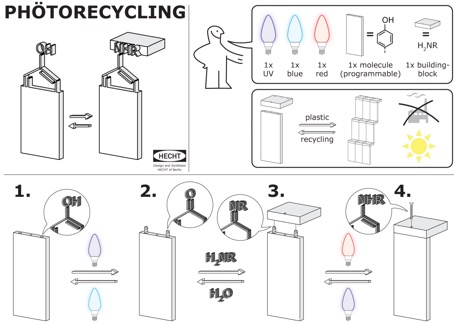Light-controlled molecules: Scientists develop new recycling strategy

A programmable molecule in combination with a specific light sequence allows for bond formation (UV and red light; 1. to 4.) or scission (UV and blue light; 4. to 1.) with molecular building-blocks. Visualization: Michael Kathan
Robust plastics are composed of molecular building-blocks, held together by tough chemical linkages. Their cleavage is extremely difficult to achieve, rendering the recycling of these materials almost impossible.
A research team from the Humboldt-Universität zu Berlin (HU) developed a molecule, which can drive or reverse specific chemical reactions with light of different colors. This enables making and breaking of connections on the molecular scale, even if they are exceptionally strong.
The discovery paves the way for the development of novel recycling methods and sustainable materials. Light-driven recovery of individual molecular building-blocks has great potential to enable recycling of yet non-recyclable plastics without compromising on color, quality, or shape.
“The working principle of our system is quite similar to the one of ready-to-assemble furniture” explain Michael Kathan and Fabian Eisenreich, the two first authors of this study. “We are able to repetitively assemble or disassemble molecular architectures, but instead of a hammer and screw-driver, we use red and blue LEDs as tools to control our molecules.”
The results of their study have just been published in Nature Chemistry.
Publication
“Light-driven molecular trap enables bidirectional manipulation of dynamic covalent systems” In: Nature Chemistry (2018), DOI: 10.1038/s41557-018-0106-8
Authors: Michael Kathan, Fabian Eisenreich, Christoph Jurissek, Andre Dallmann, Johannes Gurke, and Stefan Hecht
Prof. Stefan Hecht, Ph.D.
Department of Chemistry / IRIS Adlershof
Tel.: +49 30 2093-7365
sh@chemie.hu-berlin.de
Media Contact
More Information:
http://www.hu-berlin.de/All latest news from the category: Life Sciences and Chemistry
Articles and reports from the Life Sciences and chemistry area deal with applied and basic research into modern biology, chemistry and human medicine.
Valuable information can be found on a range of life sciences fields including bacteriology, biochemistry, bionics, bioinformatics, biophysics, biotechnology, genetics, geobotany, human biology, marine biology, microbiology, molecular biology, cellular biology, zoology, bioinorganic chemistry, microchemistry and environmental chemistry.
Newest articles

A universal framework for spatial biology
SpatialData is a freely accessible tool to unify and integrate data from different omics technologies accounting for spatial information, which can provide holistic insights into health and disease. Biological processes…

How complex biological processes arise
A $20 million grant from the U.S. National Science Foundation (NSF) will support the establishment and operation of the National Synthesis Center for Emergence in the Molecular and Cellular Sciences (NCEMS) at…

Airborne single-photon lidar system achieves high-resolution 3D imaging
Compact, low-power system opens doors for photon-efficient drone and satellite-based environmental monitoring and mapping. Researchers have developed a compact and lightweight single-photon airborne lidar system that can acquire high-resolution 3D…





















